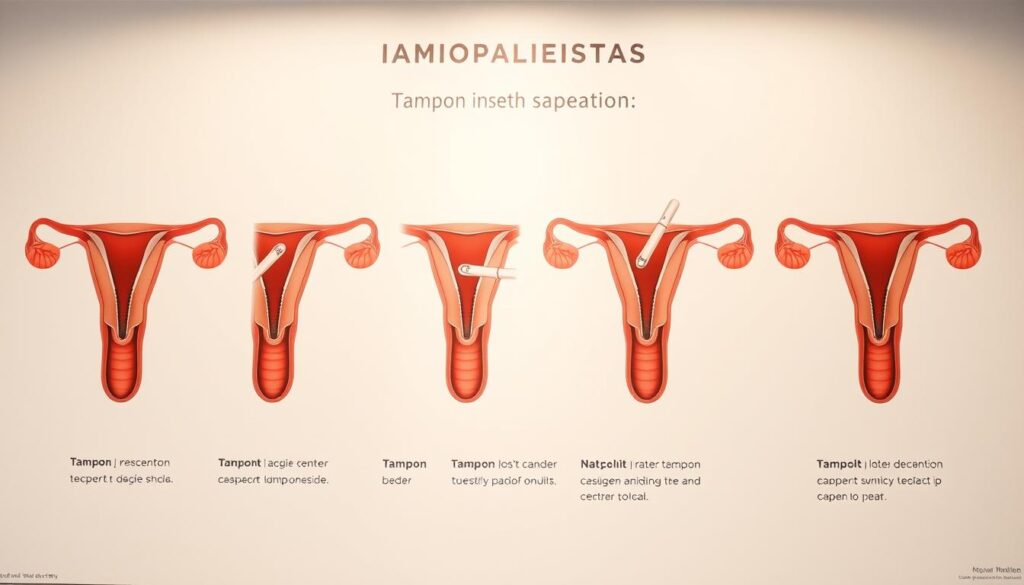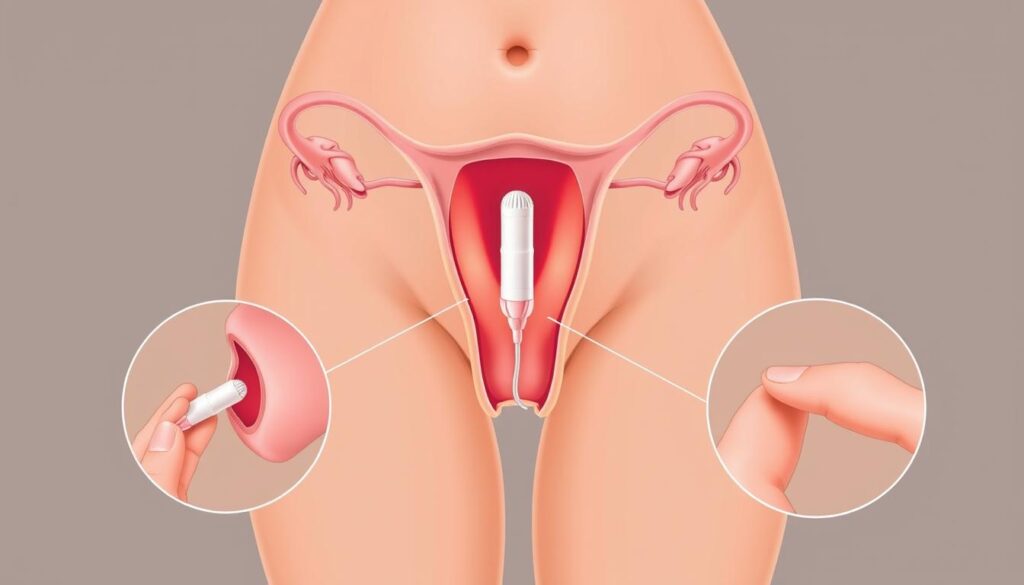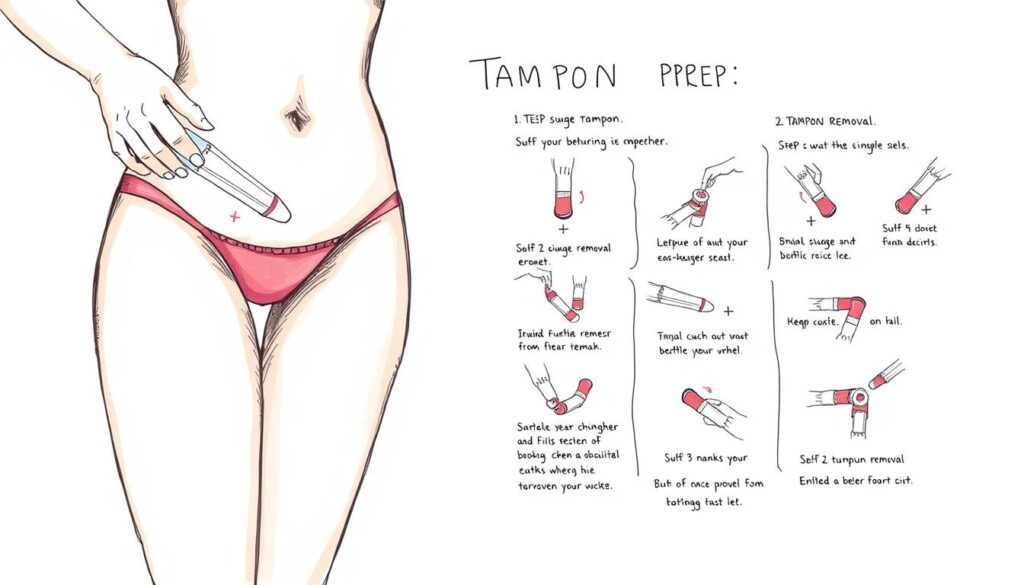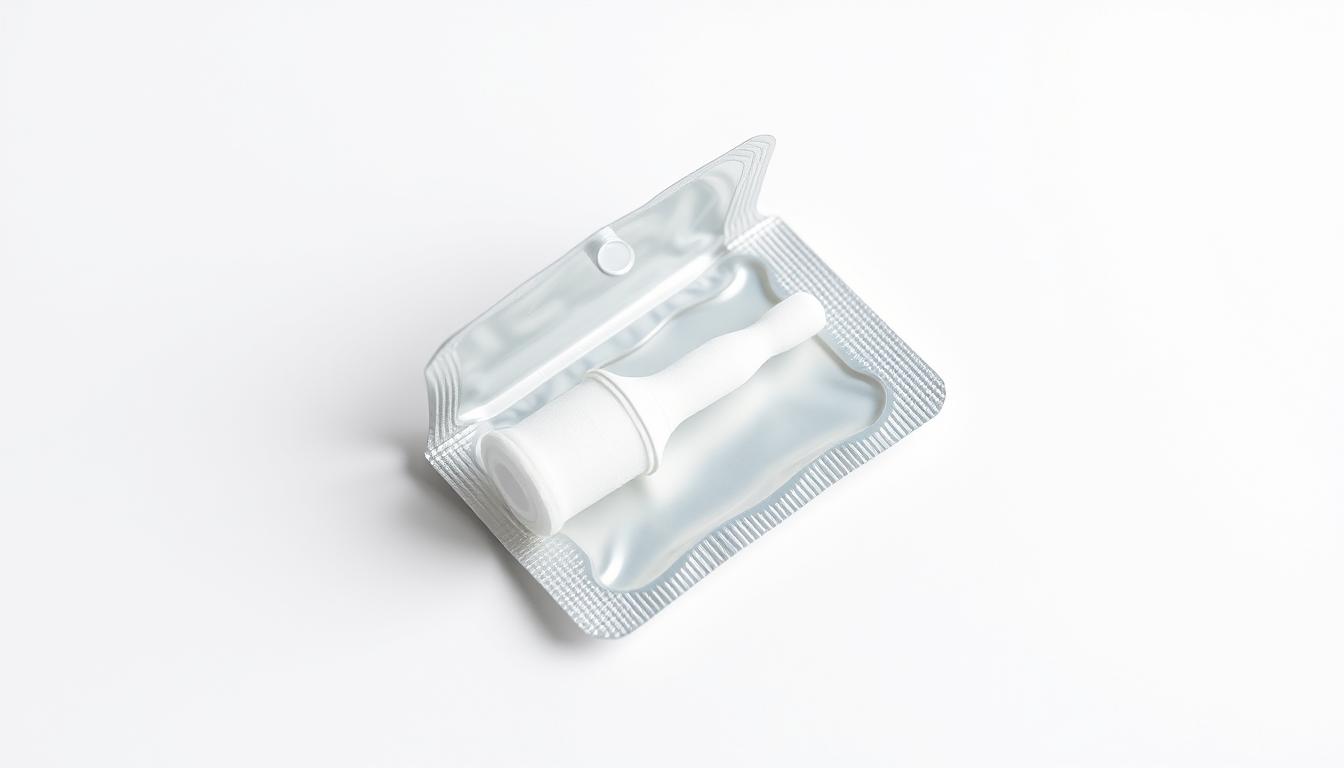Starting with feminine hygiene can be tough, like learning to wear a tampon for the first time. This guide will make you feel sure and at ease during your period.
Knowing how to use a tampon is key for freedom and ease during your period. This guide is for anyone, young or old, who wants to learn. It breaks down the steps into easy parts.
Your comfort and cleanliness are top priorities with tampons. Everyone’s experience is different. This guide offers clear, helpful info to support your choices in personal care.
Key Takeaways
- Learn the basics of tampon insertion safely
- Understand different tampon types and absorbencies
- Gain confidence in personal hygiene practices
- Discover tips for first-time users
- Recognize proper placement and usage techniques
Understanding Tampons: Basic Overview and Types
Exploring tampons can seem daunting, but our guide aims to make it easier. Choosing the right tampon is key for comfort and confidence during your period.
Our guide begins with the different types of tampons. Each one is made for specific needs, helping you find the best fit for your lifestyle and menstrual flow.
Absorbency Levels: Finding Your Perfect Match
Tampons come in various absorbency levels, from light to super. This lets you pick the right amount of protection for your needs:
- Light: Great for days with little flow
- Regular: Offers standard protection for most flow days
- Super: Best for days with a lot of flow
- Super Plus: Provides extra protection for very heavy days
Applicator Options: Plastic vs. Cardboard
Applicator type affects how easy it is to put in a tampon:
| Plastic Applicators | Cardboard Applicators |
|---|---|
| Insertion is smoother | They’re better for the environment |
| Great for beginners | They’re cheaper |
Non-Applicator Tampons: A Minimalist Approach
Non-applicator tampons are a compact choice. They need to be inserted by hand and are ideal for those who are comfortable with this method.
Success with tampons comes from finding what suits you best. Our guide helps you make choices that boost your comfort and confidence.
Essential Supplies and Preparation
Getting ready to use tampons is important. You need the right supplies for a comfortable experience. Think of this as your personal hygiene toolkit.
Before starting, collect the following essential items for successful tampon use:
- Tampons with appropriate absorbency
- Clean hands
- Panty liner (optional)
- Comfortable, private bathroom space
- Toilet paper or wet wipes
When selecting tampons, consider these tips for using tampons effectively:
- Choose the lowest absorbency that matches your flow
- Start with applicator tampons for easier insertion
- Read the instructions carefully before use
Your preparation toolkit should include multiple tampon sizes. Comfort and confidence are key during this process.
| Absorbency Level | Recommended Flow | Typical Usage Duration |
|---|---|---|
| Light | Minimal bleeding | 4-6 hours |
| Regular | Average flow | 4-6 hours |
| Super | Heavy flow | 3-4 hours |
Remember, proper preparation sets the foundation for a smooth and stress-free tampon insertion experience. Practice and patience will help you become more comfortable with each use.
Understanding Female Anatomy for Proper Insertion
Getting to know your body is the first step in learning to use a tampon. Every woman’s body is different. Knowing your body helps make using a tampon easier and more comfortable.
Our bodies have natural differences that can affect using a tampon. Knowing these details helps you feel more confident and comfortable.
Exploring the Vaginal Opening
The vaginal opening is between the urethra and the anus. It’s key to know where it is for correct tampon placement. Here are some important points:
- Located in the lower pelvic region
- Typically angled slightly upward and back
- Size and shape vary among individuals
Natural Body Positioning
Inserting a tampon correctly means knowing your body’s natural angles. Different positions can make it smoother:
- Standing with one leg raised
- Sitting on the toilet
- Squatting slightly
Finding the most comfortable position is key for successful tampon insertion. Your body will guide you to the most natural approach.
| Body Position | Insertion Ease | Comfort Level |
|---|---|---|
| Standing | Moderate | Medium |
| Sitting | High | High |
| Squatting | High | Medium |
Remember, practice and patience are key when learning to use a tampon. Each person’s body is different. What works for one might not work the same for another.
How to Wear a Tampon: Step-by-Step Instructions

Learning to use a tampon can seem scary at first. But, our detailed guide will make it easy and confident for you.
First, wash your hands well to keep things clean. Pick a comfy spot to sit or stand, like the toilet or with one leg up.
- Unwrap the tampon carefully, holding it by the applicator or base
- Get into a relaxed position that allows easy insertion
- Hold the tampon at the right angle – typically pointing slightly backward toward your lower back
- Use your free hand to separate the labia gently
- Insert the tampon slowly and steadily into the vaginal opening
Pro tip: If you encounter resistance, stop and adjust the angle. The vaginal canal has a natural curve, so aim towards your lower back for smoother insertion.
| Tampon Insertion Technique | Key Considerations |
|---|---|
| Angle of Insertion | Slightly backward, following natural body contours |
| Depth of Insertion | Deep enough that you can’t feel it, but not uncomfortable |
| Positioning | Ensure applicator or tampon is fully inside before releasing |
Getting better at using tampons takes practice. Don’t worry if it takes a few tries to feel okay. Every try helps you learn more about your body and gets better at it.
Proper Hand Hygiene and Sanitation
Keeping clean is key when using tampons. Our top tips for using tampons start with cleanliness. Your hands are your first defense against infections.
Clean hands are vital for safe tampon use. Always wash your hands well before touching a tampon. This stops harmful bacteria from getting inside you.
Effective Hand Washing Techniques
- Use warm water and antibacterial soap
- Scrub hands for at least 20 seconds
- Clean between fingers and under nails
- Dry hands with a clean towel or paper towel
Sanitization Requirements
Sanitizing goes beyond just washing your hands. Make sure your changing area is clean:
- Keep your bathroom clean and organized
- Store tampons in a dry, cool place
- Use individual packaging to prevent contamination
- Avoid touching the tampon’s absorbent end
Pro tip: Always wash your hands before and after tampon insertion or removal to minimize health risks.
Finding the Right Position for Insertion

Learning how to wear a tampon begins with finding a comfortable position. Everyone’s body is different. So, it’s important to find the right way for you.
When you insert a tampon, you have a few options:
- Sitting Position: The most common and recommended method for beginners
- Standing with one foot elevated
- Squatting stance
- Slightly leaning forward
Each position has its own benefits for inserting a tampon. The goal is to relax and find what feels natural for you.
| Position | Comfort Level | Ease of Insertion |
|---|---|---|
| Sitting on Toilet | High | Easy |
| Standing (One Foot Raised) | Medium | Moderate |
| Squatting | Variable | Challenging |
Pro tip: Relax your pelvic muscles and take deep breaths. Tension can make it harder. Try different positions to see what works best for you.
Remember, there’s no one “perfect” position. By trying different ones, you’ll find what’s most comfortable for you.
Common Insertion Mistakes to Avoid
Using tampons for the first time can be challenging. Our tips will help you avoid common mistakes and feel more confident. Knowing these mistakes is key for safe tampon use and good menstrual health.
Getting the hang of tampon use takes time and practice. Many face issues during their first tries. But, with the right advice, you can get better quickly.
Signs of Incorrect Placement
- Discomfort or pain during insertion
- Feeling the tampon constantly
- Difficulty removing the tampon
- Leakage despite using the correct absorbency
Troubleshooting Tips
- Relax your muscles during insertion
- Use a mirror to understand your anatomy
- Try different positions for insertion
- Ensure the tampon is inserted at the correct angle
| Common Mistake | Solution |
|---|---|
| Not inserting deep enough | Push the tampon further until it feels comfortable |
| Using incorrect absorbency | Match tampon to your flow intensity |
| Improper hand washing | Always clean hands before and after insertion |
Remember, following tampon safety tips means listening to your body and adjusting as needed. If discomfort persists, seek advice from a healthcare professional.
When to Change Your Tampon

Knowing when to change your tampon is key. Your body’s flow and daily life affect this. It’s important to find the right time for you.
Experts say to change your tampon every 4-8 hours. This keeps you safe and comfortable during your period.
- Light Flow: Change every 4-6 hours
- Medium Flow: Change every 4-6 hours
- Heavy Flow: Change every 3-4 hours
Don’t leave a tampon in for over 8 hours to avoid health risks. Listen to your body. Change it if you feel uncomfortable or if it’s full.
Here are signs it’s time to change:
- Feeling wet or uncomfortable
- Tampon is near full capacity
- Experiencing any leakage
- Noticing an unusual odor
Every woman’s period is different. Pay attention to your body. Adjust your tampon changing to keep yourself clean and comfy.
Signs of Proper Tampon Placement
Knowing how to put in a tampon right is key for feeling good and safe. It’s like finding the perfect outfit. You should feel like you’re wearing nothing at all.
Learning to wear a tampon means paying attention to your body’s signs. It will tell you if it’s in the right spot.
Physical Indicators of Correct Insertion
- No Discomfort: A tampon in the right spot won’t hurt or feel tight
- The string should hang outside your body at a good length
- The tampon should stay put when you move
- You shouldn’t leak or spot unexpectedly
Comfort Checks to Confirm Placement
To make sure you’ve put in the tampon correctly, do these quick checks:
- Walk around to see if the tampon feels steady
- Sit down and stand up to check if it moves
- Make sure the string is easy to reach
- Make sure you can’t feel the tampon inside you
If you feel any discomfort or odd feelings, take out the tampon and try again. It takes practice to get good at using a tampon confidently.
Managing Tampon Removal Safely

Removing a tampon is a key part of your menstrual care. Our guide shows you how to do it safely and comfortably.
When it’s time to take out your tampon, remember these important tips:
- Wash your hands well before you start
- Sit on the toilet for the best position
- Relax your pelvic muscles for easier removal
- Pull the tampon string down and out gently
If removing the tampon feels hard, don’t push. Try again softly if you meet resistance. Keeping calm helps a lot.
How you throw away the tampon is also important. Wrap it in toilet paper or use the wrapper it came with. Don’t flush it to avoid clogging your pipes.
Change your tampon every 4-8 hours to stay safe and clean. Listen to your body. If you feel any discomfort or fullness, take it out right away.
Understanding Toxic Shock Syndrome Risks
Tampons are easy to use, but knowing the health risks is key. Toxic Shock Syndrome (TSS) is a rare but serious condition. By following important tampon safety tips, you can lower your risk and use tampons with confidence.
TSS is a dangerous bacterial infection that can happen fast. It’s rare, but knowing the signs and safe tampon use is vital.
Key Prevention Methods
- Choose the lowest absorbency tampon that meets your needs
- Change tampons every 4-8 hours
- Alternate between tampons and other menstrual products
- Wash hands thoroughly before and after insertion
- Never leave a tampon in longer than 8 hours
Critical Warning Signs
Spotting early symptoms can save lives. Look out for these TSS signs:
- Sudden high fever (over 102°F)
- Widespread rash resembling sunburn
- Muscle aches and weakness
- Dizziness or fainting
- Severe vomiting or diarrhea
If you get many symptoms while using a tampon, take it out right away. Then, get medical help fast. Your health and safety are the most important when using tampons.
Choosing the Right Absorbency Level
Choosing the right tampon is key for your comfort and protection during your period. Our guide helps you pick the right absorbency level with ease.
Understanding tampon absorbency is like choosing the right outfit for the day. Each flow is different, and your tampon should fit your needs perfectly.
- Light Flow: Perfect for minimal bleeding days
- Regular Flow: Ideal for average menstrual days
- Super Flow: Best for heavier bleeding periods
- Super Plus: Designed for extremely heavy flow days
Using tampons effectively means knowing your flow and changing them every 4-8 hours. Listen to your body and pick an absorbency that keeps you dry and comfortable.
When picking your tampon, think about these things:
- Your personal flow intensity
- Daily activities and movement
- Time between tampon changes
- Comfort level
The right absorbency stops leaks and keeps you comfortable during your period. Start with the lowest absorbency that works for you and adjust as needed.
Tips for First-Time Tampon Users
Starting to use tampons can be a big step. It’s normal to feel both excited and nervous. We want to help make this experience as easy and stress-free as possible.
Using tampons for the first time needs patience and a positive attitude. Here are some key tips to help you feel more confident and ready.
Overcoming Common Fears
Many first-timers have worries about tampon use. Let’s tackle some common concerns:
- Fear of pain during insertion
- Concerns about proper placement
- Worry about leakage
- Anxiety about removing the tampon
Education and practice are the keys to overcoming these fears. Remember, your body is designed to handle this natural process.
Practice Techniques
Getting good at using tampons takes time. Here are some practice tips:
- Start with the lowest absorbency tampon
- Practice when you’re relaxed
- Use a mirror to understand your body
- Try different positions for insertion
| Practice Tip | Benefit |
|---|---|
| Use lubricant | Reduces discomfort during insertion |
| Relax your muscles | Makes insertion easier |
| Take deep breaths | Helps reduce tension |
With these tips, you’ll grow more confident and comfortable. Remember, it might take a few tries – everyone’s journey is unique.
Tampon Usage During Different Activities

Your tampon guide should be adaptable for all activities. Whether you’re at the gym, swimming, or sleeping, knowing how to use a tampon is key. It ensures you stay comfortable and protected.
Activities demand different tampon care. Athletes and those who love fitness must focus on their menstrual protection.
- Swimming: Pick a tampon with high absorption to avoid leaks in water
- Sports activities: Go for tampons that stay in place well and prevent leaks
- Sleeping: Choose a tampon with a bit more absorbency to avoid accidents at night
Our guide suggests changing your tampon every 4-8 hours, no matter what you’re doing. But during hard workouts, check and swap more often. This keeps you clean and comfy.
Here are some tips for those who are always on the move:
- Always have an extra tampon in your gym bag or sports kit
- Wear moisture-wicking clothes for extra protection
- Choose tampons made for active people
Your comfort is the most important thing. Pay attention to your body and adjust your tampon use as needed for different activities.
Conclusion
We’ve covered everything you need to know about using a tampon. It’s like learning a new skill – it takes time, effort, and a positive attitude.
Our guide has given you key info on tampon types, how to use them, and staying safe. Everyone is different, and it’s okay if it takes time to get used to.
Start this new chapter with confidence. Every try makes you more comfortable and skilled. Whether you’re new or want to improve, remember to stay informed and listen to your body. Your journey with menstrual health is unique, and you’re ready to handle it.
Keep exploring and stay curious. Trust yourself to learn and adapt. Your comfort and well-being are the most important things during this time.





